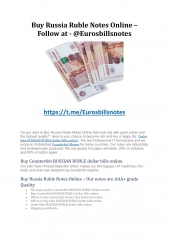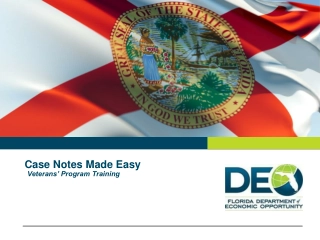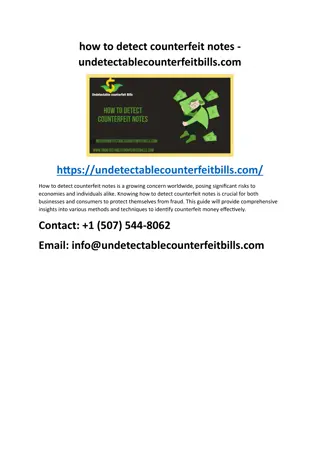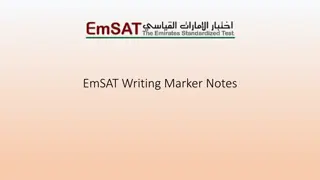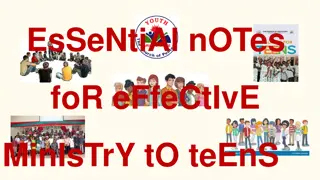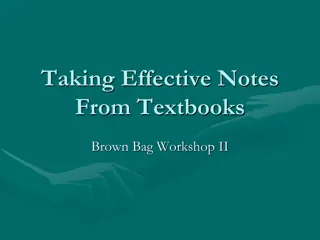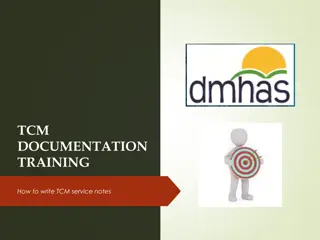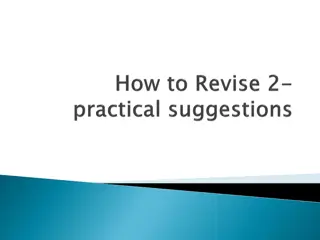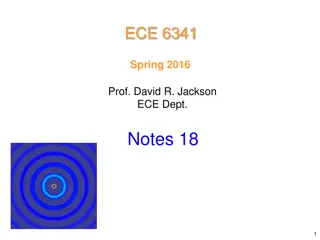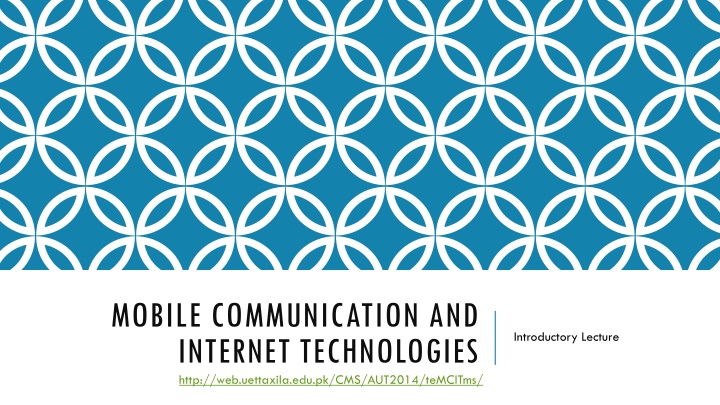
Exploring Mobile Communication and Internet Technologies Course Details
Dive into the world of mobile communication and internet technologies through this course. Learn about emerging internet multimedia services, wireless communication infrastructure, internet architecture, and more. Discover how internet services have evolved to cater to a wide range of users, emphasizing performance, security, privacy, and reliability. Explore the transformation of mobile applications using internet technologies to adapt to user demands in real time.
Download Presentation

Please find below an Image/Link to download the presentation.
The content on the website is provided AS IS for your information and personal use only. It may not be sold, licensed, or shared on other websites without obtaining consent from the author. If you encounter any issues during the download, it is possible that the publisher has removed the file from their server.
You are allowed to download the files provided on this website for personal or commercial use, subject to the condition that they are used lawfully. All files are the property of their respective owners.
The content on the website is provided AS IS for your information and personal use only. It may not be sold, licensed, or shared on other websites without obtaining consent from the author.
E N D
Presentation Transcript
MOBILE COMMUNICATION AND INTERNET TECHNOLOGIES http://web.uettaxila.edu.pk/CMS/AUT2014/teMCITms/ Introductory Lecture
COURSE ADMINISTRATION Instructor: Dr. Adeel Akram (adeel.akram@uettaxila.edu.pk) Course Coordinator: Mr. Munir Abbas (munir.abbas@uettaxila.edu.pk) Course web page: http://web.uettaxila.edu.pk/ Schedule Tuesdays 6pm to 9pm
THE NEW INTERNET In the last few years, the Internet has moved beyond the three "classical" services of email, file transfer and remote login. This course covers emerging Internet multimedia services, their technical background and open issues in depth. The course will cover the following areas with reference to their applications over wireless communication infrastructure: Internet architecture review Multicast routing and address allocation Properties of real-time services QoS: Resource reservation and differentiated services Packet scheduling Audio and video coding Streaming audio and video Adaptive applications Internet telephony Media-on-demand and content distribution networks (CDNs) Conference control Mobility (mobile IP and other technologies) e-Commerce Pervasive Computing Internet of Things
COURSE OBJECTIVE We aim to study existing Internet technologies that have evolved with the passage of time for provision of classical services to a level where they provide same services to a large number of users without compromising on performance, security, privacy and reliability. The course focusses on how internet services have been modified to provide similar services to mobile wireless users that were originally envisioned for the static wired clients. Discussion on new avenues that have emerged with the advent of newer wireless devices and communication platforms that will utilize internet technologies to serve mobile applications transforming at run time according to user s demands.
COURSE TEXT BOOK Management Information System 12th Edition Kenneth C. Laudon, Jane P. Laudon
WHAT IS COMMERCE? Middle French, from Latin commercium, from com- (together)+ merc- (merchandise) (1537) The exchange or buying and selling of commodities on a large scale involving transportation from place to place. Buying and selling ( transactions ) Large scale ( scalability) Transportation ( supply chain ) Every business process in the world must be re-engineered: Can it be made electronic? NEED TECHNOLOGY TO SUPPORT ALL OF THESE
COMMERCE (8000 B.C.) BUYER FINDS SELLER SELECTION OF GOODS NEGOTIATION SALE PAYMENT DELIVERY INFORMATION POST-SALE ACTIVITY PHYSICAL+ INFORMATION
ECOMMERCE SOME TECHNOLOGIES USED: SOME INFORMATION GATHERED: SEARCH ENGINE SEARCH BEHAVIOR BUYER FINDS SELLER ON-LINE CATALOG BROWSING BEHAVIOR RECOMMENDER AGENT CUSTOMER PREFERENCES CONFIGURATOR EFFECTIVENESS OF PROMOTIONS SELECTION OF GOODS SHOPPING BOT BARGAINING STRATEGIES AGGREGATOR PRICE SENSITIVITIES NEGOTIATION AUTOMATED AGENTS PERSONAL DATA TRANSACTION PROCESSOR MARKET BASKET SALE DATA INTERCHANGE CREDIT/PAYMENT INFORMATION CRYPTOGRAPHY PAYMENT E-PAYMENT SYSTEMS DELIVERY REQUIREMENTS DELIVERY TRACKING AGENT ON-LINE PROBLEM REPORTS ON-LINE HELP INFORMATION POST-SALE ACTIVITY CUSTOMER SATISFACTION BROWSER SHARING FOLLOW-ON SALES OPPORTUNITIES PHYSICAL+ INFORMATION INTERNET TELEPHONY
THE ELECTRONIC ENTERPRISE SUPPLY CHAIN MANAGEMENT ENTERPRISE RESOURCE PLANNING CUSTOMER RELATIONSHIP MANAGEMENT SCM ERP CRM Voice (IVR, ACD) S2S Industry- Specific Solutions Strategic Planning Svc. Auto. Demand Planning Mfg. Exec. Collab. Planning Distrib. Planning Marketing Auto. Collaborative CRM Legacy Systems Product Mgmt. Employee Systems Order Mgmt. Conf. Collaborative SCM Sales Auto. Supply Planning WH Mgmt. E-Mail Mfg. HR Finance Logistics Web Storefront Mfg. Planning Mobile Sales (Prod. CFG) Portal/ Extranet Fact. HH Devices Employee SS Trans. Mgmt. Trans. Planning Field Service Web/ Intranet E-Mail Operational EDI Closed-Loop Processing (EAI Toolkits, ETLM Tools, Embedded Mobile Agents) Direct Interaction Conf. ACD = AUTOMATIC CALL DISTRIBUTOR CFG = CONFIGURATION DM = DATA MINING DW = DATA WAREHOUSE ETLM = EXTRACT, TRANSFORM, LOAD & MANAGE HH = HAND-HELD IVR = INTERACTIVE VOICE RESPONSE DW Cust. DM Finance. DM HR DM Order DM Prod. DM KM/CM Analytical SOURCE: META GROUP
INTERNET-CONNECTED SUPPLY CHAIN Wholesale Distributors Suppliers Logistics Providers Manufacturers Supplier Exchanges Customers Logistics Exchanges Customer Exchanges Virtual Manufacturers Contract Manufacturers Information Flow Logistics Providers Goods Flow SOURCE: AMR RESEARCH (2000)
WHY E-COMMERCE? WHY NOW? Computers are faster 1973: 2013: 1 million instructions/sec 20 billion instructions/sec Have more main memory 1973: 2013: 0.125 megabytes 2 gigabytes Cost less 1973: $4,000,000 2013: $1,00
PROGRESS OF TECHNOLOGY Have more disk storage 1973: 10 MB 2013: 120,000 MB (soon 1 terabyte = 1000GB) IMPROVEMENT: 12000 x Higher communication speeds Human speech: 30 bits/sec 1973 Modem 2003 Modem: 56,000 bits/sec T1 line: 1,544,000 bits/sec DSL (high end) Internet 2: 1,000,000,000 bits/sec Optical 10,000,000,000,000 bits/sec in 1 fiber (entire U.S. telephone traffic) 1973-2013 IMPROVEMENT: 30 BILLION x 300 bits/sec 7,000,000 bits/sec
INTERNET TECHNOLOGY TOPICS Infrastructure Electronic payments Wireless Databases Web Architecture Mass personalization, CRM, Data Mining Search engines Privacy Technology Cryptography Enterprise Resource Planning Network Security Intelligent agents Data interchange
INFRASTRUCTURE FOR E-COMMERCE What worldwide structure is required to support e-Commerce? Network + communications Machines Software Protocols Security Payment interface to banking systems
THE INTERNET The fundamental technology linking business and people around the world in less than 1 second Nothing competes with it How does it work? How big is it? Who owns it? Who governs it? How does it grow? How big can it get? What architecture allows this? What are the limitations?
WIRELESS TECHNOLOGIES & M-COMMERCE Can t get (much) away from radio Differences between wireless and wired communication Cells, frequency allocations Shared medium: SDMA, FDMA, TDMA, CDMA 1G, 2G, 2.5G, 3G, 4G Wireless LAN: IEEE 802.11 Bluetooth WAP, iMode Universal Wideband (UWB)
WEB ARCHITECTURE How are web sites constructed? TIER 2 Server TIER 1 TIER 3 TIER 4 Database Applications SOURCE: INTERSHOP
SEARCH ENGINES Finding web pages Crawlers, spiders, bots Query interfaces Retrieval methods Indexing Document ranking Artificially altering retrieval order Document clustering Multilingual issues Multimedia retrieval
CRYPTOGRAPHY Secrecy Information cannot be used if intercepted Authentication We re sure who the parties are Integrity Data cannot be altered Non-repudiation Sender cannot deny sending the message Cryptography Symmetric encryption (DES, Rijndael) Public key cryptosystems (RSA) Digital signatures & certificates, public key infrastructure (PKI)
NETWORK SECURITY Access control authorization / authentication Authentication something you know: passwords something you have: smart card something you are: biometrics someplace you are: GPS Network protection, firewalls, proxy servers Intrusion detection Denial of service (DOS) attacks Viruses, worms
DATA INTERCHANGE How can sites exchange information without prior agreement? What do the data fields mean? price, extended price, unit price, prix, , , XML: Extensible Markup Language How can machines communicate without humans? How can data formats and structures be communicated? XML schemas Ontologies
eCommerce Data Exchange Needs Catalogs Quotations RFQs Purchase Orders Ship Notices Letters of Credit Electronic Payments Bills of Lading Invoices
ELECTRONIC PAYMENTS Forms of money token (cash), notational (bank account), hybrid (cheque) Credit-card transactions Secure protocols: SSL, SET Automated clearing and settlement systems PayPal Smart cards, electronic cash, digital wallets Micropayments Wireless payments Electronic invoice presentment and payment Required course: Electronic Payment Systems (20-763)
DATABASES The relational database model Query specification: SQL (Structured Query Language) Database management Databases in e-Commerce Data warehousing
MASS PERSONALIZATION & DATA MINING Treating each user as an individual key is INFORMATION How to acquire and store information about customers Cookies Question and response Clickstream analysis External databases How to use information effectively and instantly Personalization technology Customization
DATA MINING Extracting previously unknown relationships from large datasets Discovery of patterns Predicting the future past behavior as predictor of future purchasing Market basket analysis diapers/beer
DATA MINING TOOLS Visualization ( seeing the data) Predictive Modeling Database Segmentation Classify the users Link Analysis Association discovery Neural networks Systems that learn from data Deviation Detection Are any of the data unusual? Fraud detection
PRIVACY TECHNOLOGY Digital privacy & privacy threats Technology P3P EPAL Anonymity Mediation Digital pseudonyms (aliases)
ERP (ENTERPRISE RESOURCE PLANNING) & SCM (SUPPLY CHAIN MANAGEMENT) The supply network Collaboration models Vendor-managed inventory Scan-based trading ERP functions and architecture EAI (Enterprise Application Integration) Web Services
AGENTS AND ELECTRONIC NEGOTIATION Programs to perform tasks on your behalf Avatars (characters in human form) Meta-searchers, shopping bots, news agents, stock agents, auction bots, bank bots How to make agents intelligent Rule-based systems Knowledge representation Agents that learn Inductive inference JULIA from CONVERSIVE
COOPERATING AGENTS Doctor Pete Lucy s agent looks up providers, checks for distance, authorization and rating. Lucy s agent formulates a schedule of appointments for therapists that fits into Pete and Lucy s schedule. Schedule a treatment plan using only authorized providers within a 20-miles and a rating of excellent or very good. Lucy s agent retrieves information about Mom s prescribed treatment from the doctor s agent. Semantic Web Lucy SOURCE: WILLIAM HOLMES, LOCKHEED-MARTIN
M2M COMMERCE & AUCTION MODELS How can machines do business with other machines? Electronic discovery Electronic negotiation Auction strategy The semantic Web
QA &


